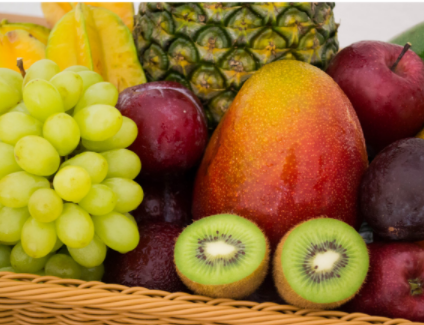Be Smart Eat Smart

Photo Courtesy of Jonas Kakaroto on UNSPLASH
Fruits like kiwis, mangos, and pineapples have lots of Vitamin C.
December 15, 2022
School food is known for its bad rap. “Gross” comes to the minds of most students when they think of it. However, how many have stepped into the school’s cafeteria? MHS’s open campus normalizes eating out every day. Village Pizza and Deli, Starbucks, Village Square bagels, and more are within five minutes’ walking. Therefore, students are more inclined to take the easy option over a more nutritional one.
For students seeking to improve their diet, prepping is key. According to health teacher Kathleen Degnan, making a grocery list for the person in your household that does the shopping can help. Furthermore, Degnan emphasizes packing a lunch the night before school so you hold yourself accountable. Mornings are busy, and it’s easy to say forget it. I’ll buy lunch instead. Packing various foods is ideal, such as lean proteins like chicken and turkey, 100% whole grain bread or wraps, fruit, greek yogurt, vegetables and hummus, salads with added proteins, and nuts.
Sometimes packing a lunch doesn’t work out, and let’s face it, eating out is expensive. Lucky for us, MHS offers a variety of options in the cafeteria. Such as salads, fruit, yogurt, chicken, pasta, pizza, deli meats, etc. A sandwich from the Central deli will run you about $12, often more. Whereas, in the cafeteria, it costs substantially less. Even with its cheaper pricing, most students at MHS do not take advantage of what is offered. Ordering pizza from Village daily may be easy, but it impacts your overall well-being. “Switch it up once in a while by drinking water instead of a Snapple,” says Degnan.
The saying, “food is fuel,” may be overused, but there’s a lot of truth to it. The things you consume impact how you perform and feel. It holds vital nutrients for the growth, repair, maintenance of body tissues, and regulation of essential processes. Degnan states, “Adopting a healthier, well-balanced diet is associated with improved academic performance, enhanced athletic performance, better sleep, improved skin, teeth, hair, etc.”. Benefits can be seen as early as a week after making the change. (add mood and mental health)
Most teenagers are not thinking about their life in thirty years when gray hairs start to pop out. However, the choices teens make now influence their life in the future. According to the CDC, foods rich in calcium, such as broccoli, keep teeth and bones strong. Fruits, vegetables, whole grains, and low-fat dairy reduce your risk of heart disease. There are numerous benefits to healthy eating. It may seem difficult to make the switch, but results will show by gradually changing your diet.






